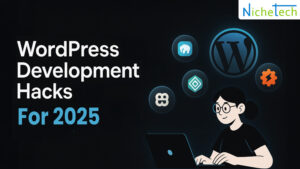WordPress has become one of the most popular content management systems (CMS) globally, powering over 40% of websites on the internet. Its flexibility, ease of use, and robust community support make it a top choice for individuals, businesses, and developers alike. However, to stand out in the crowded online space, simply using default themes and plugins may not suffice. Customizing your WordPress site with tailored themes and plugins can take it to the next level, providing enhanced functionality, performance, and design that perfectly align with your brand and business goals.
Why Choose Custom Themes and Plugins?
1. Tailored Design and User Experience (UX)
One of the main advantages of custom themes is the ability to design a website that is unique to your brand. Default WordPress themes, while functional, may lack the distinctiveness that your business needs. A custom theme allows you to create a visually appealing site that reflects your identity and enhances user experience.
Personalized Layouts: Custom themes allow for complete control over the layout, colors, fonts, and functionality, providing a fully personalized design.
Better User Experience: With tailored features, custom themes can streamline navigation and create a smoother experience for visitors.
2. Enhanced Website Performance
While some off-the-shelf themes and plugins offer great functionality, they may come with unnecessary code or features that can slow down your website. Custom themes, on the other hand, allow you to remove any bloat, which can result in faster page load times and improved website performance.
Lightweight Code: Custom themes are optimized for speed, resulting in quicker load times and better performance.
Minimized HTTP Requests: By creating a custom theme, you can limit the number of requests made by the browser to load content, helping with speed.
3. Scalability and Flexibility
As your business or website grows, you may need to add new features or update existing ones. Custom themes and plugins are highly scalable, allowing you to easily modify and enhance your website as your needs evolve.
Scalable Solutions: Custom themes and plugins can grow with your business, accommodating new features without compromising performance.
Flexibility: Unlike pre-built themes, custom solutions offer the flexibility to adjust designs and functionalities based on user feedback or emerging trends.
4. SEO Benefits
Custom themes and plugins provide the opportunity to implement SEO best practices from the ground up. With tailored elements such as meta tags, heading structures, and schema markup, Custom WordPress Sites are more likely to rank better on search engines.
Clean, SEO-Friendly Code: Custom themes can be designed to include SEO best practices and optimize site structure for better visibility in search results.
Faster Loading Times: As mentioned earlier, faster page speeds contribute to better rankings in search engines like Google.
How to Build Smarter WordPress Sites with Custom Themes
1. Start with a Solid Foundation
When creating a custom theme, it’s essential to start with a good foundation. The WordPress theme hierarchy offers a structured way to organize your theme files, ensuring that everything works cohesively.
Choose a Base Theme: Start with a starter theme, like Underscores or Sage, which offers a bare-bones framework. This allows you to focus on customization rather than building from scratch.
Plan the Layout: Sketch your layout before you begin coding. Plan your homepage, inner pages, navigation, and content structure to make sure the user experience is intuitive and seamless.
2. Optimize for Mobile and Accessibility
In today’s digital landscape, mobile-friendliness and accessibility are crucial for a successful website. Make sure your custom theme is responsive, meaning it adjusts smoothly to different screen sizes, from smartphones to desktop computers.
Mobile-First Design: Start with mobile optimization and progressively enhance the design for larger screens.
Accessibility: Ensure that your theme is WCAG (Web Content Accessibility Guidelines) compliant. This includes color contrast, keyboard navigation, and screen reader compatibility.
3. Use Custom Post Types and Taxonomies
Custom themes allow you to create specialized content types that suit your needs. Custom Post Types (CPT) and custom taxonomies are powerful tools for organizing and displaying content in an intuitive way.
Custom Post Types: If you’re running a portfolio site, an online store, or a blog, creating custom post types (e.g., “Products,” “Events,” or “Portfolio Items”) helps organize your content and display it the way you want.
Taxonomies: Taxonomies help organize content and allow users to filter or categorize it. For instance, in an online store, you might want to create taxonomies for “Brands” or “Product Categories.”
4. Customize the WordPress Backend
A custom theme can also extend to the WordPress backend, making it easier for content creators and admins to manage the site. You can simplify the backend interface, add custom fields, or tailor content-editing screens to streamline operations.
Custom Fields: Use custom fields to allow editors to input specific information, such as pricing or product features, directly from the backend.
Admin Dashboard Customization: Modify the dashboard for your content managers so they only see what’s relevant to their roles, helping to reduce clutter and increase efficiency.
How to Build Smarter WordPress Sites with Custom Plugins
1. Identify the Need for Custom Plugins
While many plugins are available in the WordPress plugin repository, there are times when off-the-shelf solutions don’t meet your specific requirements. Creating a custom plugin can offer tailored functionality that integrates seamlessly with your theme.
Unique Features: Whether you need a specialized booking system, custom forms, or an advanced search feature, custom plugins can add functionality unique to your business needs.
Avoid Bloat: Instead of relying on multiple plugins that add unnecessary features, a custom plugin can focus solely on what you need, reducing the risk of security issues or site slowdowns.
2. Keep Security in Mind
Security is paramount when developing custom plugins. Poorly developed plugins can introduce vulnerabilities to your website, making it an easy target for hackers. Make sure to follow best practices when writing secure code, such as sanitizing user inputs and using nonces for form submissions.
Follow WordPress Coding Standards: Stick to WordPress’s security guidelines to minimize risks.
Regular Updates and Maintenance: Ensure that your custom plugins are regularly updated to patch any security vulnerabilities.
3. Create User-Friendly Features
Custom plugins should prioritize usability. The more intuitive your plugin is, the easier it will be for users to interact with and benefit from its features.
Intuitive Settings: When creating a plugin, aim for a user-friendly settings panel that is easy to understand and doesn’t overwhelm the user with too many options.
Seamless Integration: Ensure that the plugin integrates smoothly with the theme and other installed plugins, providing a cohesive experience for the end user.
4. Optimize Plugin Performance
Even custom plugins can negatively affect site performance if they are not optimized. Be sure to follow best practices for writing efficient code and use caching mechanisms to ensure your plugins don’t slow down the website.
Minimize Queries: Optimize database queries to reduce load times.
Use Caching: Implement caching techniques to ensure that your plugin doesn’t require excessive server resources.
Looking Forward
Building smarter WordPress sites with custom themes and plugins offers businesses and developers the flexibility to create unique, high-performance websites that stand out in the digital landscape. Custom themes provide a distinct design tailored to your brand, while custom plugins enhance functionality and streamline workflows. By focusing on speed, scalability, security, and user experience, you can create a WordPress website that not only meets your needs but also supports long-term growth and success. Whether you’re a developer or a business owner, investing in custom themes and plugins is an investment in the future of your website.






